I guess I should wrap up The Anatomy of Kid Icarus and get it over and done with. I’m a little disappointed that people have lost interest in the Anatomy series, since it’s been a lot of fun to write. Is it that the games I’ve been covering are less interesting than the first few I did? Is the concept just tired? Has my writing become worse? I’m sincerely curious. I intend to keep producing these, but I’d like to avoid driving everyone away in the process.
Anyway… on with the analyses. Thanks as always to Rey at VGMuseum for not only being cool with me using his screenshots, but actually producing more for the games I’ve been breaking down so I have lots of material to work with. You’re a prince among men, Rey.
The fortress labyrinth of World 1-4 does more than just provide a moment’s change for how Kid Icarus plays; it actually marks a change in the game’s overall style. After each of the three labyrinths, the format of the action changes. The fortresses thus serve as a sort of transition from mode to mode.
The change in question shouldn’t come as any real surprise to gamers familiar with Kid Icarus‘ companion piece, Metroid. Like its more beloved sibling, Kid Icarus features both vertical and horizontal scrolling. And like the other game, it segregates the two directions of advancement for, one assumes, technical reasons. But where Metroid presented them almost entirely in an interlocking manner with nearly every adjacent room in the game alternating between vertical and horizontal scrolling, Kid Icarus gives you three vertical levels followed by three horizontal levels, then goes back to vertical (with a fortress marking each change, of course).
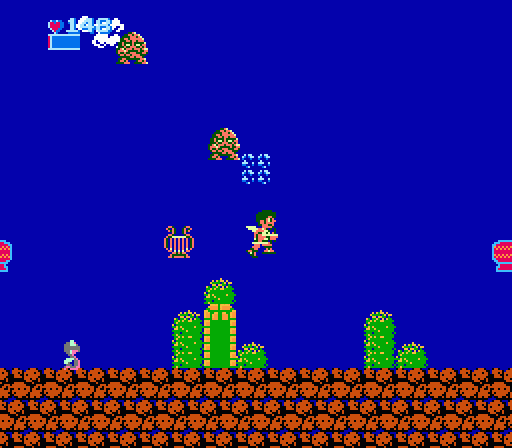
In moving to a horizontal scrolling format, Kid Icarus becomes a much more familiar style of game. Moving from bottom to top outside of fixed-screen arcade titles like Donkey Kong wasn’t too common back in 1986, whereas left-to-right scrolling was already old hat mere months after Super Mario Bros. popularized it, because there was a tremendous amount of creative convergence happening around the time Mario broke out. Within no time at all — much too soon for them to be mere copycats — the market saw a ton of other games with format similar to Mario‘s, such as Ghosts ‘N Goblins. By the time Kid Icarus rolled around to the U.S., early in 1987, side-scrolling felt natural and instinctive for anyone who spent any time at all following video games.
That’s part of what makes Kid Icarus‘ early stages so daunting (and doubly so back in its day): The underworld forces you to traverse the platforms in a way that runs counter to how the medium had already codified its preferred action in a very short amount of time. When you move into the Overworld, things become far more comfortable and intuitive for a seasoned player. The threat of falling to your death is greatly diminished, and there’s much less platforming to worry about in general since you’re traveling primarily by walking rather than by jumping. Enemies become less threatening as well, as Pit’s three-directional shooting lines up more closely with how enemies approach you. There are fewer threats creeping in from below, where Pit can’t attack them (and will potentially plummet through a platform if he tries to aim at them). All in all, the change makes a huge difference, and once you reach World 2-1 the game suddenly becomes much, much easier to deal with.
So why wait until World 2-1 to give players a more approachable format to contend with? Alas, a clever connection between story and game design is to blame. The Underworld portions of the game represent Pit’s escape from imprisonment, and it makes sense for him to be deep underground, in a dungeon, escaping to the surface. But it does mean that those first couple of stage are ludicrously difficult, creating a harsh roadblock to enjoying the game. If the designers had included something along the lines of a horizontally scrolling prologue level in which players could ease in (and maybe build up their health or attack power a notch), Kid Icarus would feel a lot less like a kick in the pants from the word go.
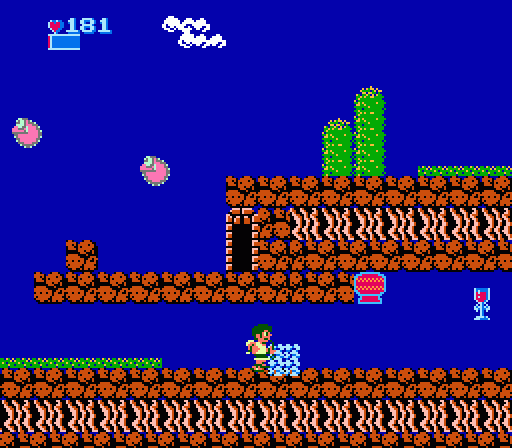
One thing that doesn’t change here is the tendency of enemies to appear in groups of four. These puffball guys, for example, leap from the bottom of the screen in evenly spaced increments, hover near the top of the screen for a moment, then drop back off. In fact, a lot of enemies here seem less like threats and more like targets of opportunity: Can you shoot them and gain hearts and experience from them before they vanish again? This is especially true for Rokmen, which are — yes — rock-men who fall from the sky in groups of four. They’re a fairly minimal threat, but if you can take a bunch of them out you’ll earn a ton of points. World 2-2 even makes a sort of test of this, with an upgrade chamber early in the stage that only essentially activates if you manage to take out the level’s opening barrage of Rokmen with flawless style.
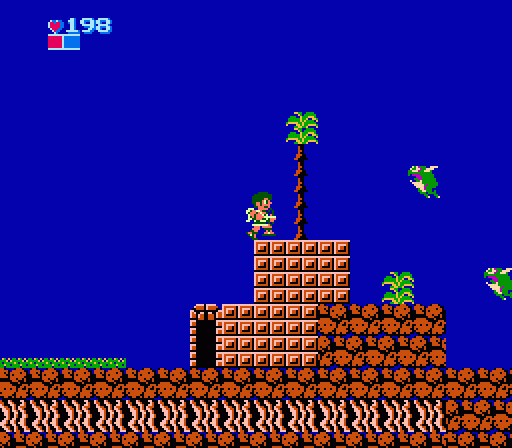
The horizontal format also diminishes the threat posed by certain other enemies. For example, the Kerons here attack a lot like Commyloose in the Underworld — but since they’re leaping at you horizontally rather than from below, they’re far more predictable and thus less dangerous.
“Keron,” of course, is an absolutely detestable pun, combining Charon (the boatman of the River Styx) with “kero,” the Japanese onomatopoeia for a frog’s utterances.

The Overworld continues to offer split paths as you advance, frequently dividing the road into high and low paths. Usually one path or the other has a chamber or health refill. Sometimes you won’t know which is the better path until you’ve committed — remember, no backward scrolling in this game, even in the Overworld — while other forks actually offer different items on each path and force you to choose one or the other.
In terms of play, the upper path usually gives you more room to maneuver while making Pit slightly more vulnerable to enemies approaching from above or below. And generally speaking the lower path is typically more sheltered but makes it tougher to dodge enemies. In any case, there’s more of a “grab bag” feel to the branching paths in the Overworld, because you’re less likely to die in this much easier section of the game than you were in the Underworld. In the opening stages of the game, the high difficulty level means you have a tendency to traverse the levels repeatedly before you finally reach the end, so you become very familiar with the route details. Here, there’s a pretty good chance you’ll never see a stage a second time, which means there’s more of a lottery feel to your choices. Granted, I’m speaking from my own experiences here, but I can’t believe they’re completely atypical. The Overworld is simply much less harrowing.
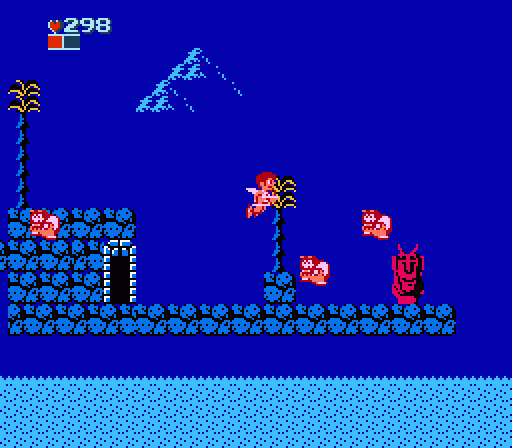
Which isn’t to say it’s without its hazards. The worst of them is definitely Pluton, the robber god. These guys are the worst. They move more or less like Keron, taking bounding leaps of various and unpredictable sizes. They don’t actually move until Pit crosses their line of sight, though, meaning you may need to get close to them before they attack. And they’re completely invulnerable.
What makes Pluton so annoying, however, isn’t its movement or invincibility but rather the fact that if one bumps into Pit, it’ll steal one of his hard-earned weapons. You can earn those weapons back in the training rooms, or you can buy them from a merchant for an insane amount of cash, but the net effect of being struck by a Pluton is that Pit is semi-permanently weakened, losing one of his key tools.
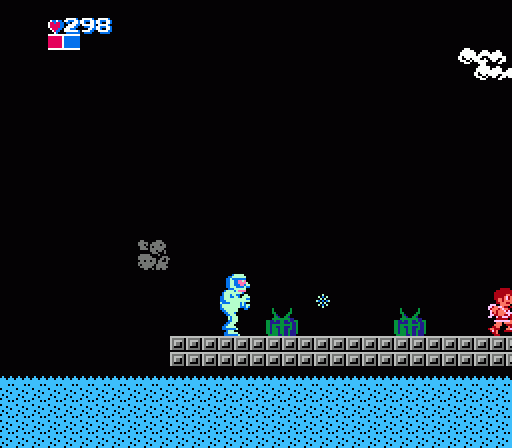
Thankfully, Plutons only appear in a handful of places. They’re ridiculously difficult to avoid in their initial appearance, but afterwards you’re given reasonable opportunity to lead them and trick them. The one good thing about Plutons is that they’re set in their movements and can only travel forward. They’ll frequently fall off the screen near pits, and their ability to move through scenery (but only upward) means they will often become lodged in walls and forced to move to a higher level. They’re dangerous and devious, but passing them unscathed is not impossible.
The other unique foes of the Overworld pale in comparison to Plutons. The most dangerous is probably the Snowman, who soaks up a ton of hits while firing fast-moving snowballs that can span the length of the screen. He has a tendency to show up near pits, often large ones that can only be traversed via moving platforms (which, incidentally, you’ll still fall through if you duck). While a tough threat, the Snowman actually feels more in line with enemies you’d find in “typical” action/platform/shooter games of the era, your Mega Mans and whatnot. As such, he’s much easier to deal with.

In fact, as you work your way through the Overworld, you’ll find fewer and fewer new and surprising elements. There are vines and magma and other hazards to avoid, moving platforms over yawning chasms, and so on and so forth; but by and large we’ve seen bulk of the quirky, idiosyncratic elements that make Kid Icarus seem so weird compared other games. They’re largely front-loaded, which means that at this point the game doesn’t offer many more surprises. This is yet another factor that contributes to the fact that it’s much, much more difficult at the beginning than toward the end.
I don’t want to over sell out, but seeing a new post in the Anatomy series is like getting a Christmas present every time. The only reason I don’t jump on buying the books as fast as I did the Spite books is because money is tight and I good off for the coffee table, color books for the level maps. Speaking as a Gabe designer, there aren’t a lot of practical guides, mostly just beginner level books that cover general theory and principles. There’s a need for literature that covers systems, mechanics, level design and how they can be mplemented effectively and Anatomy helps fill that gap. I how you stick with it, I’ve already recommended it to a few peers and will continue to do so to keep awareness and interest up. What ever happens though, thanks for everything so far Jeremy.
I don’t think interest in the Anatomy series waned, it just might be people’s overall disinterest in Kid Icarus? Anyway, nice write up, I do like how the stages also went from day time to night in 2-3, that felt like a nice time transition.
I know you’ve touched on the steep initial curve of difficulty in Kid Icarus before, but thinking about it again, I think that’s the exact reason I’ve replayed it less than a lot of other Nintendo games of the era. I’ve played Zelda II a couple of times, and that game’s a real jerkface by the end, but it has the advantage of starting out pretty easy and fun. Pop in Kid Icarus on the other hand and you’re immediately reminded of almost every annoyance the game has to offer. I’ve finished Kid Icarus once. I’ve played a level or two and then turned it off a lot of times.
Which explains why I was nodding along to the familiar screenshots of the first world and then looking at these and not really remembering this part of the game.
I’m still enjoying these in-depth retrospectives quite a bit and I’m certain I’m not the only one. I guess people don’t really have to much interesting to say about Kid Icarus. I’ll admit I was a victim of the difficulty curve and by the time I was skilled enough to play it we had already gotten rid of our NES.
I’m going to jump on this here bandwagon to say that yes, Anatomy of a Game most likely still gets the same kind and amount of attention from your loyal readers, but that, because of the game, most of them lurk’n’read instead of commenting.
While I know I’m speaking for nobody but myself, Anatomy of a Game is one of the most fun game design article series I follow. And while I’m not as interested in Kid Icarus as I would be in another Zelda or Metroid AoaG, I still loyally read them for fun and continuity.
As for the Journals up for purchase, I am still saddened by the fact I simply cannot purchase them because I lack the payment options available on the website you have them on. This is mostly the fault of the site, because there’s not even something like PayPal available. Ridiculous, I’ll say.
Your followers still read your works. But if I’m supposed to be the norm, they probably aren’t as enthusiastic over this particular game as opposed to the more mainstream games.
Actually, there’s been a significant drop-off in readership on Anatomy articles over the past three or four months — not just comments. After a flurry of briefly renewed interest in the first couple Super Mario Bros. entries, traffic in general to these has been pretty dead.
Just wanted to say Anatomy is by far my favorite thing you produce, if possible keep it up.
Does the drop-off correlate with the server move by any chance? I know I missed, like, a month of posts because the RSS feed I’d subscribed to stopped working. I missed any warnings of the change that got posted…
Actually, traffic leapt considerably with the server move because I restored the toastyfrog and gamespite domains, then tailed off over time.
You’ve actually got a pretty excellent writing style, Mr. Parish. The worst one could complain about in these articles is a typo here and there, and honestly one would have to be a jerk to do so because one is getting all this awesome content for exactly zero dollars.
I’m saddened the traffic has dropped off because I really enjoy these articles. As someone above said, it feels a bit like Christmas morning every time there’s a new entry. I love Kid Icarus but can understand if people are a bit less interested in it; hopefully the traffic will return once we’re back to covering a game with a bit more universal appeal.
I will do my part and start actively recommending AoaG to people I know.
The only reason I hadn’t commented much is because I hadn’t replayed Kid Icarus in a few years. Rectified that just recently with the 3D Classics port.
After beating it again, one thing that stands out to me are how many derivative enemy types there are. Foes that fly around in groups of four. Fortress enemies that fly around the room just like Specknoses. Things that move about slowly primarily placed on platforms. Three flavors of monsters that pop out from under your feet with no warning to shoot you. It’s almost like Wario World, where many enemies are just the same old foes wearing a different skin.
As for Pluton, the worst of those guys are near the end of 2-3. If you’re not taking a slow pace, you’ll get mugged by an army of those arrow proof bastards with no way to avoid them and lose all your special tools.
But anyway, Kid Icarus is totally a game with front-loaded difficulty. By the time you get to the Overworld, you should have a couple of life upgrades and an arrow upgrade. You’re more likely to die from falling through an iceberg than you are by any other hazards.
Uh, why did Kid Icarus need pressing down to drop through surfaces again? I can’t remember any specific moments when that move is mandatory.
Personally, I really like the Anatomy series. That said, I have very little interest in Kid Icarus, and I’m not totally familiar with the game, so there’s that. If the traffic dropping off extends to before Kid Icarus, then the only thing I could complain about was that SMB went on a little too long. It’s a big, important game and all that; I’m just speaking of personal preference.
Would love to see something even more left field (for your writing, that is) like, say, the Genesis Sonic games.
Ooh, +1 for something left-field. How about an obscure but still fairly traditional platformer, like Rockin’ Kats or Bucky O’Hare?
Or if that’s not far afield enough, there is at least one reader here who would be absolutely gratified to be reading “The Anatomy of Dudes with Attitude.”
I can’t speak for others, but I still greatly enjoy the Anatomy series.
It may simply be the game selection. Personally, I’ve enjoyed the write ups more when it’s a game I’m familiar with. If I was forced to rank your efforts Donkey Kong Jr. and Kid Icarus would fall towards the bottom not because the writing or insight is any worse but simply because not being as familiar with the source material makes it have less of an impact. I find I’m having the most fun when I’m nodding my head as I read the post. I actually watched a Let’s Play-something I never do-for Castlevania II while reading your analysis because I just wasn’t able to understand the nuances of the articles since I spent so little time with that game.
Or it simply could be that once you run out of Super Mario Bros and Castlevania titles to write about interest from the general public starts to wane. Try doing a Mega Man or Super Metroid and see if it picks back up.
I’m still reading the hell out of all of these, but I could see less people following this here than the Castlevania games just because, frankly, this game’s a bit of a mess. Game length factors in too.
With Castlevania, you have honestly one of the shorter platformers out there, so you had the luxury of REALLY taking a detailed look, practically commenting on each individual pit and monster, and there’s such a deliberateness to the design that there’s interesting things to say about them. The same applies to the Critical Look at Mega Man Stages thread that inspired these.
With SMB that loses a little steam because hey, there’s 32 levels to get through. Here, lots of decisions aren’t actually very well-thought out, so the tone drifts more towards criticism than a lesson in game design.
No~! I’d be massively sad to see the Anatomy series end.
I really love the deep analysis you apply to these games. It moves them beyond being mere nostalgia pieces and into predecessors of game design.
It’s already hard enough to find this kind of analysis about video games. I’d hate to see one great example fade into the aether….
Like I said, I don’t intend to stop doing Anatomy. I’m just trying to pin down the malaise.
I use these articles as inspiration to play the games that I have not already played or finished. So, I love reading them most of the time. I had difficulty getting through the SMB ones because I was not altogether interested. I love the SMB sequels, but I have difficulty getting into the first game.
My interest in AoG is still very high. I would agree that it might have to do with the choice of games.
Do you still intend to remain at 8Bit or will you also analyze 16Bit? In this case, you might want to pick a highly popular game like Super Metroid or Zelda III to see if the choice of games effects the traffic numbers.
I still like the Anatomy series! 😀
I almost always enjoy the Anatomy stuff! I usually don’t comment because I don’t really have anything to say.
I come here everyday hoping to see a new Anatomy entry (or a Mad Men analysis).
But personally, I don’t care much about Kid Icarus (or Metroid 1). My interest will surely fly high again once you Anatomize Zelda 3 or Metroid 3.
I check every day for new Anatomy articles. Cannot get enough of it.
I consider the Anatomy series to be one of the most important products of this site.
Please keep writing! The Anatomy series is one of the few quality in-depth articles worth reading on the whole internet, in my opinion. I don’t know why your traffic for this series has dropped off (probably due to the unfamiliarity of Kid Icarus) but I’d really love you to check out some other left-field classic games and do similar writeups.
For instance, you could do the first few levels of Battletoads then get to the speeder bikes and move on to another game after hours of utter frustration.
Just wanted to say that I don’t read the articles on the site at all because I buy the books and found it kind of redundant to read the book I did read online (Zelda 1 and 2) once I had it in print. I’m glad to see most folks are enjoying the online posts, though, and they’re probably right about it being Kid Icarus. I’m probably the exception in that I am looking forward to reading the Kid Icarus things, just… not online, is all.